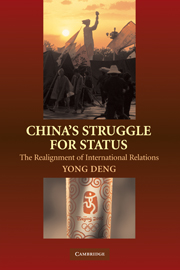Book contents
- Frontmatter
- Contents
- Figure and Tables
- Preface
- 1 Introduction
- 2 International Status and Chinese Foreign Policy
- 3 Negotiating the Human Rights Standard
- 4 Reacting to “China Threat Theories”
- 5 Strategic Partnerships with Russia, the European Union, and India
- 6 Independent Rivalry with Japan
- 7 Rediscovering Asia and Africa: The Multilateral Turn
- 8 Taiwan and China's Rise
- 9 China's Foreign Relations and the Emerging Great-Power Politics
- Index
7 - Rediscovering Asia and Africa: The Multilateral Turn
Published online by Cambridge University Press: 05 September 2012
- Frontmatter
- Contents
- Figure and Tables
- Preface
- 1 Introduction
- 2 International Status and Chinese Foreign Policy
- 3 Negotiating the Human Rights Standard
- 4 Reacting to “China Threat Theories”
- 5 Strategic Partnerships with Russia, the European Union, and India
- 6 Independent Rivalry with Japan
- 7 Rediscovering Asia and Africa: The Multilateral Turn
- 8 Taiwan and China's Rise
- 9 China's Foreign Relations and the Emerging Great-Power Politics
- Index
Summary
The idea of Asian regionalism after the Second World War had its genesis with the rising power of Japan in the 1960s. Directly or not, Japan was the architect of the major regional institutions and forums, official and private. The government as well as prominent individuals saw Asian regionalism as a secure footing to facilitate Japan's “return to Asia.” Bearing the imprint of the unique Japanese style and interests, these institutional undertakings have made a valuable contribution to the economic development, interdependence, and cooperative dynamics in the region. With the rise of the People's Republic of China, the question inevitably arises as to how it approaches regional integration and multilateral diplomacy in Asia.
The PRC started to seriously consider joining regional institutions in the 1980s. Initially, reformist leaders, such as Premier Zhao Ziyang, wanted to tap into the economic dynamism in East Asia to spur Chinese economic modernization. Later, the ruling Chinese Communist Party elites also began to see institutional involvement as an inescapable part of its regional diplomacy. But they were then worried about the U.S. and Japanese dominance, while at the same time uncertain of the impact of regional integration on Chinese sovereignty and conflicted national identity. The informal, nonintrusive, and gradualist style of the Asian institutional approach assuaged some of these concerns, thereby facilitating tentative PRC engagement. Since the mid-1990s, however, China has demonstrated unprecedented activism and growing leadership in multilateral initiatives in Asia.
- Type
- Chapter
- Information
- China's Struggle for StatusThe Realignment of International Relations, pp. 200 - 244Publisher: Cambridge University PressPrint publication year: 2008



